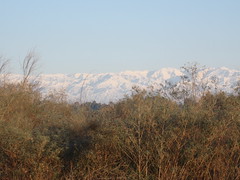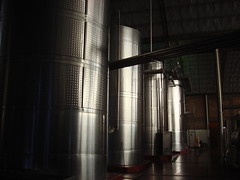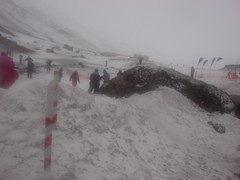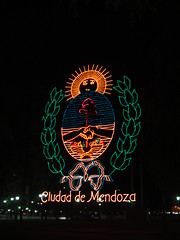Mendoza
 We spent the last three days of our time in Argentina in Mendoza, the capital of the powerhouse wine-producing region of the same name. During our stay, we took a half-day tour of two wineries and an olive oil plant, a full day tour of the high Andes region and the Río Mendoza, spent a few nights out on the town, and stayed at Hostel Lagares, definitely a downgrade from the Hotel Orquideas but still a nice hostel with good mattresses and incredibly friendly and knowledgeable staff. Our tours and lodging were booked ahead of time by Say Hueque Travel Agency, and it turns out sometimes that it's nice to have things arranged for you, especially when there's somebody standing at the bus station to ferry you to the hostal after your 18-hour overnight bus ride from Salta to Mendoza.
We spent the last three days of our time in Argentina in Mendoza, the capital of the powerhouse wine-producing region of the same name. During our stay, we took a half-day tour of two wineries and an olive oil plant, a full day tour of the high Andes region and the Río Mendoza, spent a few nights out on the town, and stayed at Hostel Lagares, definitely a downgrade from the Hotel Orquideas but still a nice hostel with good mattresses and incredibly friendly and knowledgeable staff. Our tours and lodging were booked ahead of time by Say Hueque Travel Agency, and it turns out sometimes that it's nice to have things arranged for you, especially when there's somebody standing at the bus station to ferry you to the hostal after your 18-hour overnight bus ride from Salta to Mendoza.Our afternoon visit to the two wineries and the olive oil plant, situated in nearby Maipú, were quite educational, and also tasty.
 The first winery visited was called Lopez, and it had a fairly large processing facility within the town limits of Maipú. The grapes are delivered from their fields within the region, and processed in large metal drums. Some of the red wines are then aged in French oak barrels, while whites are aged in a huge vats. We tasted two of their wines in their wine cellar, a sparkling white and a red, which were decent, but nothing too exciting, in our opinion. However, it was nice to hear that they use an all-natural process - the yeast on the skins from the grapes are the only things that go into the fermentation process - and that the left-over mash is returned to the field to fertilize the grape vines.
The first winery visited was called Lopez, and it had a fairly large processing facility within the town limits of Maipú. The grapes are delivered from their fields within the region, and processed in large metal drums. Some of the red wines are then aged in French oak barrels, while whites are aged in a huge vats. We tasted two of their wines in their wine cellar, a sparkling white and a red, which were decent, but nothing too exciting, in our opinion. However, it was nice to hear that they use an all-natural process - the yeast on the skins from the grapes are the only things that go into the fermentation process - and that the left-over mash is returned to the field to fertilize the grape vines.Next we toured a small olive oil plant, a welcome change from the winery, where we learned the ancient (and fairly simple, it turns out) art of creating cold-pressed extra-virgin olive oil, Essentially the olives (they use three different varieties to create their blends) are crushed (pits and all) by a giant stone mill into a paste, which is loaded onto mesh trays, the trays are stacked, and then pressed by a hyrdaulic press, squeezing out the oil and water, which is collected and kept in a series of vats as the oil natuarally separates from the water. All of this is temperature controlled to keep the acidity down, The final product, after weeks of sitting in the vats, is some tasty olive oil, which we were able to sample on pieces of bread along with sun-dried tomatoes and raisins. The left-overs of the process, the mash of olives, is then sold off to various other parties that will chemically extra the remaining oils, use the products to create cosmetics, or simply return it to the field as fertilizer.
The second winery we visited was Don Arturo, a small, family run bodega that produces high end Malbecs, Cabernet Sauvignons, Merlots, Syrahs that are both aged in bottle and aged in French oak casks, depending upon the level of the wine. They also produce a few varietals of white, and sell the wine only in their showroom, which keeps prices down. We loved their lower-end Cabernet Sauvignon (aged for a few months in French oak) and Malbec (only aged in the bottle), and were lucky enough to be able to sample their higher-end Cabernet Sauvignon (aged much longer in French oak) in the showroom when one of the family members came in provided us with a special tasting. It was so good that we spent 50 pesos (roughly US$13) for a bottle, and contemplated splurging on their super high-end limited edition celebration wines (a Malbec and a Cabernet Sauvignon). The wine is good enough, in my opinion, that it could probably fetch US$50 to US$100 if it were sold in the United states. We didn't get the chance to try to their celebration wines, sadly, although we were seriusly considering paying the money to ship a case back to the United States.
 We also spent a full day touring (mostly in the tour van) the Andes to the west of Mendoza, following along the route that connects Argentina to Chile, and driving all the way to the frontier. We made several stops along the way - to the artifical lake that was created when they damned up the Mendoza river (the water of which is used for irrigating the wine region and also all of the trees in the city of Mendoza via a complex system of canals), stopped in the town of Uspallata for a coffee and a pastry called a tortita mendocina (it was arond Uspallata that the movie Seven Years in Tibet was actually filmed), then proceeded up toward the pass, following the Mendoza river and passing along glacial formations with the Andes all around us. Finally, we drove to the very checkpoint that separates Chile from Argentina, then turned back to have lunch and some free time at a nearby restaurant and snow park. It was freezing cold. It was snowing. A strong wind was blowing. We thought we had prepared well enough, but we were also freezing cold. After lunch, we ended up spending most of the time in the tour van. But it was also incredibly beautiful - the Andes, as we have now seen them from both sides and travelled among them in Ecuador, Peru, Chile, and Argentina, are incredibly majestic, powerful forces of nature jutting up at the collision of two tectonic plates.
We also spent a full day touring (mostly in the tour van) the Andes to the west of Mendoza, following along the route that connects Argentina to Chile, and driving all the way to the frontier. We made several stops along the way - to the artifical lake that was created when they damned up the Mendoza river (the water of which is used for irrigating the wine region and also all of the trees in the city of Mendoza via a complex system of canals), stopped in the town of Uspallata for a coffee and a pastry called a tortita mendocina (it was arond Uspallata that the movie Seven Years in Tibet was actually filmed), then proceeded up toward the pass, following the Mendoza river and passing along glacial formations with the Andes all around us. Finally, we drove to the very checkpoint that separates Chile from Argentina, then turned back to have lunch and some free time at a nearby restaurant and snow park. It was freezing cold. It was snowing. A strong wind was blowing. We thought we had prepared well enough, but we were also freezing cold. After lunch, we ended up spending most of the time in the tour van. But it was also incredibly beautiful - the Andes, as we have now seen them from both sides and travelled among them in Ecuador, Peru, Chile, and Argentina, are incredibly majestic, powerful forces of nature jutting up at the collision of two tectonic plates.Despite all of this touring around the region, were also able to spend some time in Mendoza itself, exploring the area around Plaza Independencia and the various smaller plazas, and along Avenida Villanueva, which is where a bunch of restaurants and clubs are. The city, dead during the afternoon when stores close and everyone takes a lunch break or siesta, comes to life at night, with both locals and tourists taking to the streets to wander around, shop, hang out in the park, play soccer, buy crafts, and socialize. We were amazed at the number of people out, in the cold weather in winter, and can only imagine how happening it must get during the warmer summer months.
 Our last night in Mendoza, and Argentina, we spent wandering through Plaza Independencia, with its glowing Christmas-light wire sculpture of Inti the sun god smiling down while hands shake in a message of friendship welcoming people, taking pictures, watching the fountain, before heading over Plaza España and the restuarant La Tasca for one of the best meals we've had in Argentina.
Our last night in Mendoza, and Argentina, we spent wandering through Plaza Independencia, with its glowing Christmas-light wire sculpture of Inti the sun god smiling down while hands shake in a message of friendship welcoming people, taking pictures, watching the fountain, before heading over Plaza España and the restuarant La Tasca for one of the best meals we've had in Argentina.A Spanish-based tapas restaurant with red painted walls hung with paintings from local artsists along with prints from a least one famous South American (that was either Guayasamín or a knock-off on the wall [see our previous entry about visiting Guayasamín's Capilla del Hombre in Quito, Ecuador]), the items on the menu fit perfectly, with a definite South American flare over what would be considered traditinoal Spanish tapas. Karla and I shared everything for dinner, which consisted of spiced olives, vegetables au gratin (mostly various squashes, carrots, and tomatoes), mussels in a saffron sauce, shrimp and clam kebab, and abadejo (a white, ocean-dwelling fish imported from Chile) in a green sauce. And, of course, we drank our bottle of Don Arturo Cabernet Sauvignon, a perfect compliment to the strength of the olives and vegetables, alhtough we could have done with a white for the fish. Nevertheless, this did not diminish the fact that everything tasted incredible - every single course, well (and correctly) herbed and spiced (remember that Argentinians don't generally like spicy food), and cooked perfectly (clams that melted in your mouth, white fish that was flaky yet moist, baked vegetables that still held their form...). We finished the meal with a lemon mousse and a small cup of honey grappa. A perfect last dinner in Argentina.

No comments:
Post a Comment